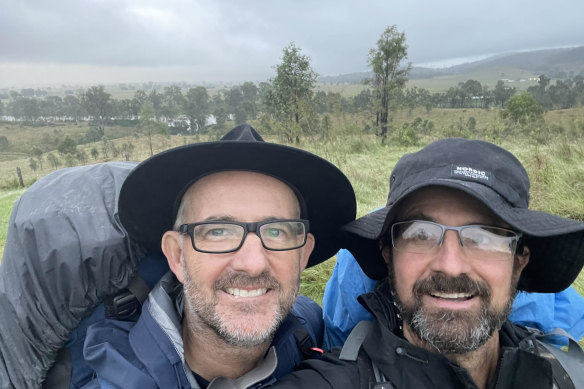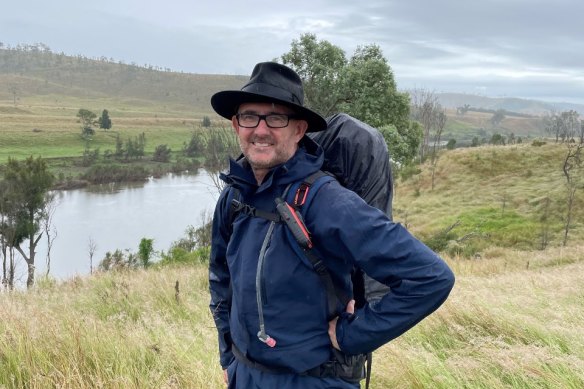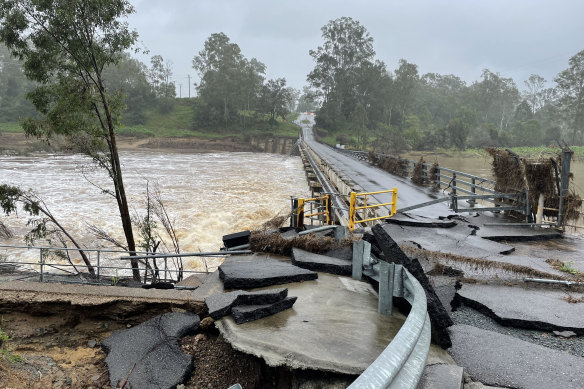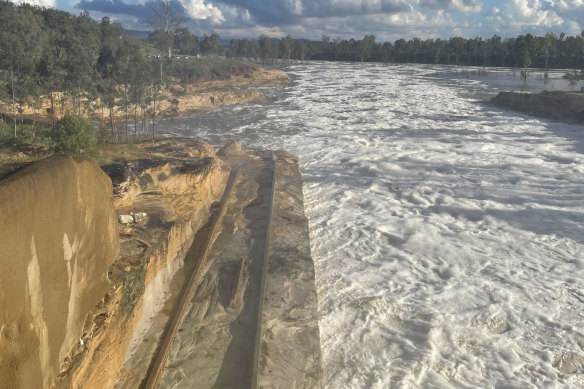This was published 10 months ago
Simon set out to walk the entire length of the Brisbane River. Then the rains came
By Nick Dent

Simon Cleary with his brother Ian, a former National Parks guide, on the Upper Brisbane River, in May 2022.Credit: Simon Cleary
Ten days into his journey walking the Brisbane River, author Simon Cleary and his brother arrived at a remote cabin on a hill near Caboonbah, north of Lake Wivenhoe. They intended to spend one night there.
They awoke to the pounding of rain on the corrugated iron roof.
“It was the wettest May on record,” Cleary says of that month in 2022. “The banks of the river were impossible to traverse. The creeks were also impassable.”
They ended up stuck in the cabin for four days – “not knowing whether or not the rain would stop, not knowing whether we would be able to find a route ultimately around Lake Wivenhoe”.
Soon, both the nearby highways were cut by floodwaters. To make matters worse, his brother was struck down with COVID-like symptoms. This was the moment when Cleary had to ask himself: had he made a huge mistake?

Author Simon Cleary on the Upper Brisbane River, 2022. It took him just under a month to walk its length.Credit: Simon Cleary
Cleary’s self-imposed mission to walk the length of the Brisbane River (Maiwar) from its western source at Mount Stanley to the river’s mouth in Moreton Bay is recounted in his book Everything Is Water (UQP).
A barrister by trade who has published three novels, Cleary was inspired to hike the river by curiosity about the Brown Snake that winds through our city. It was also a sentimental journey.
“I grew up on the escarpment of the Great Dividing Range in Toowoomba, so I used to play as a kid in tiny creeks that ultimately fed the river,” he says.
“And the other thread is that a great-grandfather of mine was the chief steel engineer on the construction of the Story Bridge.”
The 344-kilometre walk, which ultimately took 27 days, required a great deal of planning. Landowners had to be contacted for permission. Food drops organised. A succession of walking companions scheduled, ranging from family members to experts – a hydrologist, an academic, a journalist.
In the end, he made it – but not without grim detours trudging along highways, and a couple of stretches by boat and canoe. He slipped over “100 times”, fell into the drink. No day’s walking ever went as planned. On Day 19 he hiked into riverside scrub so thick that by nightfall there was nowhere flat to pitch a tent. “It was one of those nights where you’re in a sleeping bag and you’re sliding down the incline,” he laughs.
On the way he collected stories, many related to the creeks he was constantly encountering. There’s the story of John Wickham, who travelled with Charles Darwin on the Beagle and ended up living in Newstead House. Or of flecks of gold found on the banks near Indooroopilly, which led to the naming of the El Dorado Cinema.
Some stories verge on myth: such as that of horseman Billy Mateer, who rode like Paul Revere from Lake Somerset to Brisbane to warn of a 1893 flood. Or the chilling tale of the Kilcoy Massacre of at least 30 First Nations people given poisoned flour in the 1840s.

“I feel the surging water vibrating through my body. I stand on the bridge and am suddenly vulnerable”: Flood damage at Mt Crosby Weir. Credit: Simon Cleary
Everything Is Water also records Cleary’s learnings on river conservation. For example, the Brisbane River cod is now extinct thanks to the upstream migration of introduced tilapia. “There are a thousand ways to kill a waterway,” he writes. “Build industrial plants on its banks… pour effluent into it… suffocate a river with nutrients, watch the algae bloom.”
“As you walk through what used to be the lands of five Indigenous nations you can’t help but reflect on how that land was managed for many millennia,” Cleary says.
“This is a precious resource, and the city of Brisbane wouldn’t exist without it. We just can’t afford to treat the river as anything other than essential to our very being.”
‘We just can’t afford to treat the river as anything other than essential to our very being.’
Simon Cleary
Because of the 2022 floods the river’s contours constantly confounded his expectations. But there were pleasant surprises as well, such as arriving at Wivenhoe Dam, a “place of astonishment”.

Day 15: Water is released from Wivenhoe Dam – ‘inconceivable volumes with extraordinary power’.Credit: Simon Cleary
The kindness of strangers also amazed him. “I got an enormous amount of logistical help from people who lived on the river who gave me guidance and advice, and introductions.”
There were encounters with kangaroos, emus, deer, and one very clingy dachshund. Snakes were blessedly few. “It’s snake country,” he says. “I’d chosen May because most of the snakes were hibernating.”
But would Cleary, an experienced walker who has hitchhiked in West Africa, do it again? Or another similar journey?
He laughs. “I’m just going to let this one settle in a little bit at the moment.”
Everything Is Water (RRP$34.99) is published by University of Queensland Press.